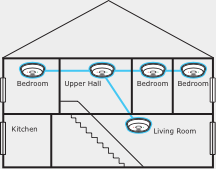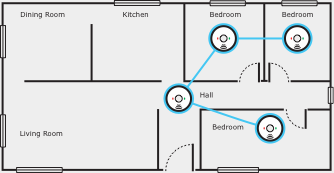From 1 January 2022
- All homes or units being sold or leased, or existing leases renewed, will require hardwired photoelectric, interconnected smoke alarms. Non-removable 10-year battery smoke alarms can be installed in place.
- Smoke alarms in the dwelling must:
- be photoelectric (AS3786-2014); and
- not also contain an ionisation sensor; and
- Be hardwired to the mains power supply, if currently hardwired. Otherwise, smoke alarms can be either hardwired or powered by a non removable 10 yr battery or a combination of both.
- be interconnected with every other smoke alarm in the dwelling so all activate together.
- The legislation requires smoke alarms must be installed in the following locations:
- on each storey
- in each bedroom
- if there is no hallway, between the bedroom and other parts of the storey; and
- if there are no bedrooms on a storey, at least one smoke alarm must be installed in the most likely path of travel to exit the dwelling.

What’s required by law?
When it is time for your property’s alarms to be upgraded, those alarms must:
- be photoelectric and comply with Australian Standard 3786-2014
- not also contain an ionisation sensor; and
- be less than 10 years old; and
- operate when tested; and
- be interconnected with every other ‘required’ smoke alarm in the dwelling so all activate together.
Any existing smoke alarm being replaced from 1 January 2017 must be a photoelectric-type alarm which complies with Australian Standard 3786-2014.
If a smoke alarm which is hardwired to the domestic power supply needs replacement, it must be replaced with a hardwired photoelectric smoke alarm.
In existing domestic dwellings, it is possible to have a combination of smoke alarms (240v and battery operated) and interconnectivity can be both wired and/or wireless.
What to buy?
Smoke alarms must comply with the Standard AS 3786-2014. The body of the alarm must be marked with AS3786-2014.



Leave A Comment